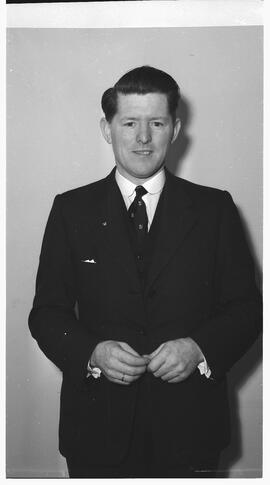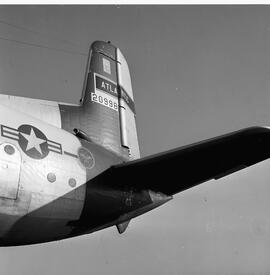Identity area
Reference code
Title
Date(s)
- 1958-2000 (Creation)
Level of description
Extent and medium
c.167 standard boxes
Context area
Name of creator
Administrative history
In 1957, The Shannon Airport Development Authority (SADA) was set up with the aim to make Shannon Airport more appealing through the promotion of freight traffic and the development of nearby tourist facilities.
In 1959, SADA became the Shannon Free Airport Development Company (SFADCo). SFADCo would receive funding from the government and have the additional functions of establishing an industrial estate and housing for workers.
In 2014, Shannon Development was amalgamated into Shannon Group (later The Shannon Airport Group), a conglomerate of aviation, property, and tourism businesses created to drive the economy of the west of Ireland.
Archival history
Shannon Development was established by the Irish Government in 1959 as an agency to promote Shannon Airport and the Shannon region. It is responsible for the creation of Shannon Town, Ireland’s first New Town and for the Shannon Free Zone, the world’s first modern free trade zone.
The Shannon Development archive comprises photographic material, press cuttings, reports, brochures, and other documentation spanning over five decades.
While in the care of Shannon Development, the photographic material was stored in a standard office environment. The negatives were placed in glassine sleeves and earlier on the glassine sleeves were kept in paper envelopes. These envelopes note a number, a brief description and initials which are believed to be the initials of the photographer. There are 28 corresponding registers which note the reference number of the negative, a date and a brief description.
In 2014, Shannon Development was amalgamated into Shannon Group, a conglomerate of aviation, property, and tourism businesses created to drive the economy of the West of Ireland. It was at this time that the collection was transferred to the University of Limerick in two consignments on 22 December 2014 and 5 January 2015. Digitisation and listing began in July 2018, with some of the collection listed and imputed into Adlib software.
In 2021, the Special Collections and Archives Department at the Glucksman Library was awarded funding from the Wellcome Trust to catalogue, conserve, digitise and increase accessibility to the Shannon Development Photographic Archive, as part of the New Jerusalems project. This project aims to increase accessibility to archives from eleven post-war New Towns in England, Wales and Ireland. This cataloguing began in 2023. Existing catalogue entries were reviewed and edited where necessary. Following a move to AtoM, cataloguing was continued. The negatives were rehoused in new acid free envelopes and renumbered. Please note that this collection is in the process of being catalogued.
Immediate source of acquisition or transfer
Transferred on loan from Shannon Group Plc. to the University of Limerick in two instalments on 22 December 2014 and 05 January 2015.
Content and structure area
Scope and content
The collection comprises approximately 250,000 photographic items, including press cuttings, reports, brochures spanning over five decades. Of particular significance are the photographs taken between 1959–1998, which visually capture the Shannon Development story, and provide unique insights into the life in Ireland in the latter half of the twentieth century. It chronicles the evolution of Shannon town, as well as the broader Shannon region from a large agricultural base to a leading industrial and tourism centre. There is also material relating to the wider Clare Region, Limerick, Tipperary, Offaly, and Kerry.
The photographs include images of the many people of renown that passed through Shannon Airport, coverage of the world’s first duty free zone and images of newly acquired aircraft. The early construction days of Shannon Town and people at work in associated industrial settings are also captured. There are many photos of events at Bunratty Castle, Knappogue Castle, Dromoland Castle, Cragaunowen and the Cliffs of Moher, which provide a valuable insight into the development of new tourist attractions in the region during the 1960s.
Besides offering a visual account of the development of the airport and its environs, the collection offers unique opportunities to consider a range of topics including life, culture, dress, and some of the social norms of Ireland in the latter half of the twentieth century.
Appraisal, destruction and scheduling
All records have been retained.
Accruals
No accruals are expected.
System of arrangement
The negatives have been left in their original order based on the numbers given to them and the corresponding registers. The registers are arranged chronologically. This collection is not yet fully catalogued but future series will include contact sheets, prints, CDs and DVDs, Video Tapes, Reels, Cassettes.
Conditions of access and use area
Conditions governing access
Unrestricted access to most items. Some items contain sensitive material and are closed.
Conditions governing reproduction
Copyright retained by Shannon Group Plc. Standard copyright regulations apply to all items. For photocopying or reproducing material, please consult with the staff.
Language of material
Script of material
Language and script notes
Physical characteristics and technical requirements
Photographs, video recordings, press cuttings, reports and publications created by Shannon Development.
Material is mostly in good condition. Some negatives have also been lost or damaged. A number of negatives suffer from vinegar syndrome. Such items have been identified in the descriptive catalogue. Some negatives have also been lost over the years. In such cases, the description of the negative is still recorded. Some numbers were also skipped in the sequence, and this is also recorded.
Finding aids
Allied materials area
Existence and location of originals
Existence and location of copies
Digitised copies have been created and are available on the UL Digital Library and can be accessed through AtoM where possible.
Related units of description
Additional material can be found relating to Shannon in the Irish Architectural Archive and in the Clare County Archives.
Notes area
Note
Some items contain sensitive or offensive imagery and are closed. There are also some photographs and register descriptions which are considered inappropriate today but are reflective of their time, and which some viewers may find offensive. Please see https://archives.ul.ie/harmful-language-statement for more information.
Alternative identifier(s)
Access points
Subject access points
Place access points
Name access points
Genre access points
Description control area
Description identifier
Rules and/or conventions used
This description follows guidelines based on ISAD(G) 2nd edition (2000), Irish Guidelines for Archival Description (2009), National Council on Archives: Rules for the Construction of Personal, Place and Corporate Names (1997) and EAP Guidance on Data Protection for Archive Services (2018).
Status
Level of detail
Language(s)
Script(s)
Sources
Carey, Olive, ‘Between Old World and New World,’ A Social History Project, Dúchas na Sionna, 2014 https://www.clarelibrary.ie/eolas/coclare/history/between_old_worlds_new_shannon.htm
Lichfield, Nathaniel. Interim Report on the Economic, Social and Technical Problems of the Planning of the Limerick City/South Clare/Shannon Industrial Estate Complex. Printed by the Limerick Leader, 1965.
Ó Muircheartaigh, The Chronicle of Clare 1900-2000, Fág an Bealach, 2000.
O’Connell, Brian and Cian O’Carroll, Irish Innovator, visionary & Peacemaker Brendan O’Regan, Irish Academic Press, 2017.
Ryan, Liam, Shannon, Ireland's new town: a social survey, Department of Sociology, University College Cork, 1969.
Social Trends in Shannon Town: Report of a Special Census, Shannon Development Company March 1975.
Stephens, J.P, ‘Shannon Attracts Home Hunters,’ May 1977, The Clare People 1977-80, Accessed in the Clare Archives, 25 October 2023.
Archivist's note
Papers arranged and described by Kate Harris from April 2023-March 2025.










